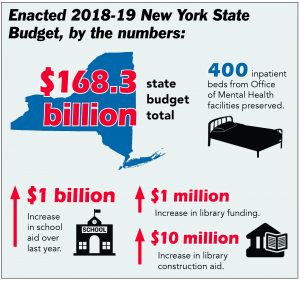 The enacted, $168.3 billion, 2018-19 New York State Budget addressed in a positive way many of our union’s concerns about adequate public services and resources.
The enacted, $168.3 billion, 2018-19 New York State Budget addressed in a positive way many of our union’s concerns about adequate public services and resources.
Within the spending plan were changes to the Taylor Law that will help protect CSEA members from the negative implications of Janus v. AFSCME Council 31, which the U.S. Supreme Court will decide later this spring. This is a major win for CSEA, and shows the power and strength of our union.
The enacted budget helps safeguard key public services that New Yorkers rely on every day.
“This budget is a step in the right direction toward protecting the vital public services that New Yorkers rely on every day,” CSEA President Danny Donohue said. “Under tough circumstances, this budget takes into account the need to find solutions other than cutting services even more. Public services have long been stretched too thin, and our members who provide these services keep having to do more with less.”
The final budget includes funding for the 400 state Office of Mental Health (OMH) inpatient beds that were proposed to be cut. The legislature and executive reached an agreement that will keep facilities open, and will require OHM to increase its reporting on future bed reductions.
Legislators also rejected the proposal to close the Office of Children and Family Services’ (OCFS) Ella McQueen Reception Center in Brooklyn with only 30-days notice and restored the center’s funding. If the state intends to close the facility, it must do so with the required one-year notice.
The legislature restored the $78.6 million operating subsidy to the state’s three safety-net, State University of New York (SUNY) hospitals, which protects vital health care services, particularly for our state’s poor, indigent and uninsured citizens.
Education and library aid also got a boost in the enacted budget. School district aid increased by about $1 billion over last year. The final plan restores $12 million in community college aid that was initially proposed to be cut. The enacted budget increases library funding by $1 million and library construction aid by $10 million over last year.
Also rejected were proposals that would have capped the reimbursement of Medicare Part B premiums for retirees in the New York State Health Insurance Program (NYSHIP) and eliminate the state’s reimbursement of the Income Related Monthly Adjustment Amounts (IRMAA) for higher-income retirees.
The final budget also includes several proposals meant to mitigate the negative impacts of federal tax reform on New Yorkers, raises $100 million through an opioid “stewardship” payment on manufacturers and distributors, increases resources to the Metropolitan Transportation Authority (MTA) and creates a new optional retirement savings program for private-sector employees.
For more details on the state budget, visit cseany.org.




